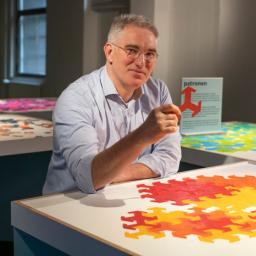Designers who become even more creative with a robot in their team, using Twitter to predict the stock market, and catching a single bacterium in the act of infecting a cell – these are all examples of how artificial intelligence has penetrated every corner of science in Zuid-Holland. Three researchers talk about the diversity of the work they do using AI.
Competing in the AI age
Rotterdam School of Management, Erasmus University (RSM) | Ting Li, Professor of Digital Business
 Professor of Digital Business Ting Li studies how companies can benefit from data at the Erasmus Centre for Data Analytics. You probably don’t realise it, but Google gets smarter with every search you make. “It’s a learning algorithm and it’s becoming more and more precise. The more often we click on a page, the higher that page will appear in the list of search results”, she explains.
Professor of Digital Business Ting Li studies how companies can benefit from data at the Erasmus Centre for Data Analytics. You probably don’t realise it, but Google gets smarter with every search you make. “It’s a learning algorithm and it’s becoming more and more precise. The more often we click on a page, the higher that page will appear in the list of search results”, she explains.
AI is everywhere, says Li. It’s in cars and banking systems, in dating sites and all over the media. Companies often use recommendation systems – a form of AI – to recommend products, such as movies on Netflix, music on Spotify, and all manner of items on Amazon. “You might think that you never click on those recommendations, but 30 to 35% of Amazon’s sales come from smart recommendation systems that are increasingly being fine-tuned by their data engineers”, she says.
One of Li’s PhD students is helping an insurance company to understand why customers switch from the one insurer to another. “We analyse the data to find out whether customers are mainly motivated to switch by comparison sites such as Independer, by Google search ads, by links on other websites, or after being called by a sales representative”, Li continues.

Stock market forecasting with Twitter
In another project, Li is investigating whether you can predict the stock market using Twitter or Facebook. “Algorithms can browse through those media and distil sentiments. For example, based on the sentiment ‘Apple did well in the first quarter’ you might be able to predict how their share price will go”, she says. It’s not certain whether this will work yet; it could also be that the sentiment only becomes more positive after the share price has risen.
It is not just about making money. “You could also improve your service based on such data and AI systems. For example, I work with public transport companies who want to improve their fare structure based on travel patterns, or ensure that passengers do not have to stand.” Li describes the core of her research as follows: “I’m always looking to understand the relevance of information, be it for the benefit of companies, individuals or society as a whole.”
 AI literally opens new worlds for the life sciences
AI literally opens new worlds for the life sciences
Ariane Briegel, Professor of Ultrastructure Biology
Bacteria caught red-handed, deeply frozen just as they were about to cause Lyme’s disease. Professor Ariane Briegel is wildly enthusiastic about the wonders she observes thanks to three elements: a freezing technique, a camera-equipped microscope, and AI. ‘It’s fascinating. Every single cell is different.’
Bacteria follow their ‘nose’ towards a food source. Well, strictly speaking not their nose, but their receptor proteins. Neatly ordered like a honeycomb, Briegel has watched them prick through cell walls. On the outside they catch signals; on the inside they set the cell to work swimming in the right direction.
From 100 slices to 3D images with smart software
The camera in Briegel’s microscope takes approximately one hundred photographs of the same number of cell slices. Smart software then turns these hundred photographs into an understandable 3D image. Daar zit een grote verdienste van kunstmatige intelligentie. Een mens kan niets met honderden foto's van celplakjes. Dimensie-reductietechnieken uit de AI-wereld kunnen zulke data vertalen tot een beeld dat wij begrijpen. This has literally opened a new world for Briegel and her colleagues: they can observe in great detail what cell structures and organs look like and how bacteria ‘get moving’.
And the fun has only just begun. ‘When I completed my PhD twenty years ago, I was producing two datasets a day at most. These days it’s forty to fifty a day, far more than researchers could ever look at. And we want to tackle even larger projects.’ Like mapping the 1.5 kilograms of bacteria on and inside the human body. Infection, cancer, growth: with these techniques, we will soon be able to map in detail so many biological systems in the life sciences.'
Read more at universiteitleiden.nl/ai





